Related Research Articles
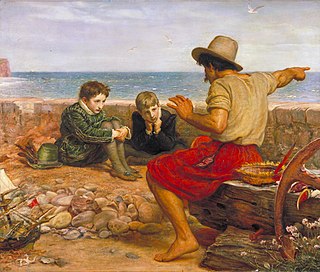
Storytelling is the social and cultural activity of sharing stories, sometimes with improvisation, theatrics or embellishment. Every culture has its own narratives, which are shared as a means of entertainment, education, cultural preservation or instilling moral values. Crucial elements of stories and storytelling include plot, characters and narrative point of view. The term "storytelling" can refer specifically to oral storytelling but also broadly to techniques used in other media to unfold or disclose the narrative of a story.

Early modern human (EMH), or anatomically modern human (AMH), are terms used to distinguish Homo sapiens that are anatomically consistent with the range of phenotypes seen in contemporary humans, from extinct archaic human species. This distinction is useful especially for times and regions where anatomically modern and archaic humans co-existed, for example, in Paleolithic Europe. Among the oldest known remains of Homo sapiens are those found at the Omo-Kibish I archaeological site in south-western Ethiopia, dating to about 233,000 to 196,000 years ago, the Florisbad site in South Africa, dating to about 259,000 years ago, and the Jebel Irhoud site in Morocco, dated about 315,000 years ago.
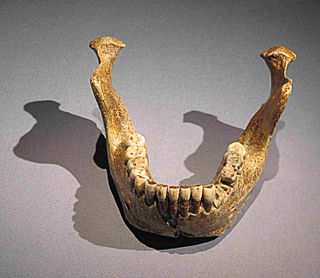
Homo heidelbergensis is an extinct species or subspecies of archaic human which existed from around 600,000 to 300,000 years ago, during the Middle Pleistocene. Homo heidelbergensis was widely considered the most recent common ancestor of modern humans and Neanderthals, but this view has been increasingly disputed since the late 2010s.
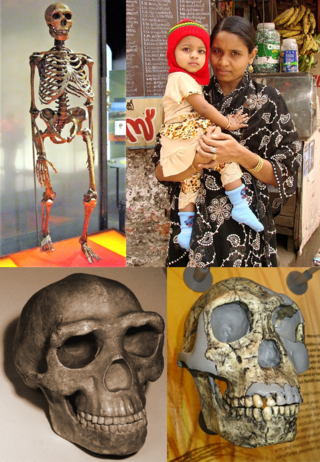
Homo is a genus of great ape that emerged from the genus Australopithecus and encompasses only a single extant species, Homo sapiens, along with a number of extinct species classified as either ancestral or closely related to modern humans; these include Homo erectus and Homo neanderthalensis. The oldest member of the genus is Homo habilis, with records of just over 2 million years ago. Homo, together with the genus Paranthropus, is probably most closely related to the species Australopithecus africanus within Australopithecus. The closest living relatives of Homo are of the genus Pan, with the ancestors of Pan and Homo estimated to have diverged around 5.7-11 million years ago during the Late Miocene.
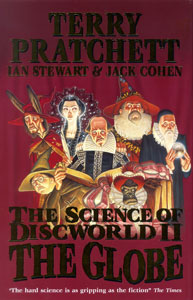
The Science of Discworld II: The Globe is a 2002 book written by British novelist Terry Pratchett and science writers Ian Stewart and Jack Cohen. It is a sequel to The Science of Discworld, and is followed by The Science of Discworld III: Darwin's Watch.
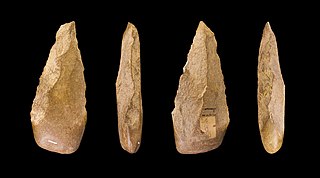
The Lower Paleolithic is the earliest subdivision of the Paleolithic or Old Stone Age. It spans the time from around 3.3 million years ago when the first evidence for stone tool production and use by hominins appears in the current archaeological record, until around 300,000 years ago, spanning the Oldowan and Acheulean lithics industries.

Homo rhodesiensis is the species name proposed by Arthur Smith Woodward (1921) to classify Kabwe 1, a Middle Stone Age fossil recovered from Broken Hill mine in Kabwe, Northern Rhodesia. In 2020, the skull was dated to 324,000 to 274,000 years ago. Other similar older specimens also exist.
Walter Fisher (1931–2018) was an American academic credited with formalizing Kenneth Burke's Dramatism and introducing the narrative paradigm to communication theory. Fisher was Professor Emeritus at the Annenberg School for Communication.
Narrative paradigm is a communication theory conceptualized by 20th-century communication scholar Walter Fisher. The paradigm claims that all meaningful communication occurs via storytelling or reporting of events. Humans participate as storytellers and observers of narratives. This theory further claims that stories are more persuasive than arguments. Essentially the narrative paradigm helps us to explain how humans are able to understand complex information through narrative.
Organizational storytelling is a concept in management and organization studies. It recognises the special place of narration in human communication, making narration "the foundation of discursive thought and the possibility of acting in common." This follows the narrative paradigm, a view of human communication based on the conception of persons as homo narrans.
Human taxonomy is the classification of the human species within zoological taxonomy. The systematic genus, Homo, is designed to include both anatomically modern humans and extinct varieties of archaic humans. Current humans have been designated as subspecies Homo sapiens sapiens, differentiated, according to some, from the direct ancestor, Homo sapiens idaltu.

Archaic humans is a broad category denoting all species of the genus Homo that are not Homo sapiens, which are sometimes also called Homo sapiens sapiens, in which case the singular use of sapiens has been applied to some archaic humans as well. Among the earliest modern human remains are those from Jebel Irhoud in Morocco, Florisbad in South Africa (259 ka), Omo-Kibish I in southern Ethiopia, and Apidima Cave in Southern Greece. Some examples of archaic humans include H. antecessor (1200–770 ka), H. bodoensis (1200–300 ka), H. heidelbergensis (600–200 ka), Neanderthals, H. rhodesiensis (300–125 ka) and Denisovans.
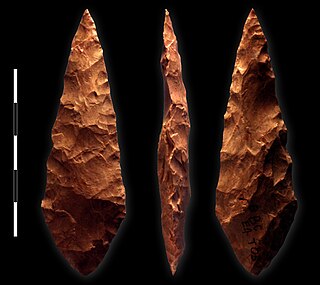
The Middle Stone Age was a period of African prehistory between the Early Stone Age and the Late Stone Age. It is generally considered to have begun around 280,000 years ago and ended around 50–25,000 years ago. The beginnings of particular MSA stone tools have their origins as far back as 550–500,000 years ago and as such some researchers consider this to be the beginnings of the MSA.

In addition to the generally accepted taxonomic name Homo sapiens, other Latin-based names for the human species have been created to refer to various aspects of the human character.

The Hominidae, whose members are known as the great apes or hominids, are a taxonomic family of primates that includes eight extant species in four genera: Pongo ; Gorilla ; Pan ; and Homo, of which only modern humans remain.

William Robert Catton, Jr. was an American sociologist known for his scholarly work in environmental sociology and human ecology. More broadly, Catton is known for his 1980 book, Overshoot: The Ecological Basis of Revolutionary Change, which is credited by younger generations of environmental scholars and activists as foundational for their own works in calling attention to humanity's role in expanding ecological overshoot to the global level.
Narrative communication is a kind of a detached communication, where the person who is speaking is more involved in what he/she says rather than in the person who he/she is saying it to.
Self-persuasion is used to explain one aspect of social influence. This theory postulates that the receiver takes an active role in persuading himself or herself to change his or her attitude. Unlike the direct technique of Persuasion, Self-persuasion is indirect and entails placing people in situations where they are motivated to persuade themselves to change. More specifically what characterizes a self-persuasion situation is that no direct attempt is made to convince anyone of anything. Thus, with self-persuasion, people are convinced that the motivation for change has come from within, so the persuasion factors of another person's influence is irrelevant. Therefore, Self-persuasion is almost always a more powerful form of persuasion than the more traditional persuasion techniques. Self-Persuasion, also has an important influence in Social judgment theory, Elaboration Likelihood Model, Cognitive Dissonance and Narrative paradigm.

Political narrative is a term used in the humanities and political sciences to describe the way in which storytelling can shape fact and effect understandings of reality. However, political narrative is not only a theoretical concept, it is also a tool employed by political figures in order to construct the perspectives of people within their environment and alter relationships between social groups and individuals. As a result, fiction has the potential to become fact and myths become intertwined into public discourse. Political narrative is consequential in its ability to elicit pathos, allowing the narrative to be influential through the value it provides rather than the truth that is told.

Homo longi is an extinct species of archaic human identified from a nearly complete skull, nicknamed 'Dragon Man', from Harbin on the Northeast China Plain, dating to at minimum 146,000 years ago during the Middle Pleistocene. The skull was discovered in 1933 along the Songhua River while the Dongjiang Bridge was under construction for the Manchukuo National Railway. Due to a tumultuous wartime atmosphere, it was hidden and only brought to paleoanthropologists in 2018. H. longi has been hypothesized to be the same species as the Denisovans, but this cannot be confirmed without genetic testing.
References
- ↑ Kurt Ranke, 'Kategorienprobleme der Volksprosa', Fabula, 9(1-3) (1967), 4–12 (p. 6) doi : 10.1515/fabl.1967.9.1-3.4; Kurt Ranke, 'Problems of Categories in Folk Prose', trans. by Carl Lindahl, Folklore Forum 14(1) (1981), 1-17 (p. 5).
- ↑ Cf. Albrecht Lehmann, 'Homo narrans: Individuelle und kollektive Dimensionen des Erzählens', in Erzählkultur: Beiträge zur kulturwissenschaftlichen Erzählforschung: Hans-Jörg Uther zum 65. Geburtstag, ed. by Rolf Wilhelm Brednich (Berlin: de Gruyter, 2009), pp. 59-70 (p. 59) ISBN 9783110214710.
- ↑ Rhodes, C. and Brown, A. D. (2005) Narrative, organizations and research. International Journal of Management Reviews, 7 (3). pp. 167-188. doi : 10.1111/j.1468-2370.2005.00112.x.
- ↑ Jenny Mandelbaum, 'Interpersonal Activities in Conversational Storytelling', Western Journal of Speech Communication, 53.2 (1989, 114-26 doi : 10.1080/10570318909374295.
- ↑ Walter R. Fisher, 'Narration as a Human Communication paradigm: The Case of Public Moral Argument', Communication Monographs, 51 (1984), 1-20 (p. 6) doi : 10.1080/03637758409390180 repr. Archived 2018-12-22 at the Wayback Machine in Contemporary Rhetorical Theory: A Reader, ed. by John Louis Lucaites, Celeste Michelle Condit, and Sally Caudill (New York: The Guilford Press, 1999) pp. 265-87 (p. 270).
- ↑ Cf. Walter R. Fisher, 'The Narrative Paradigm: In the Beginning', Journal of Communication, 35(4), 74–89 (1985), 74-89 doi : 10.1111/j.1460-2466.1985.tb02974.x.
- ↑ Terry Pratchett, Ian Stewart and Jack Cohen 2002.